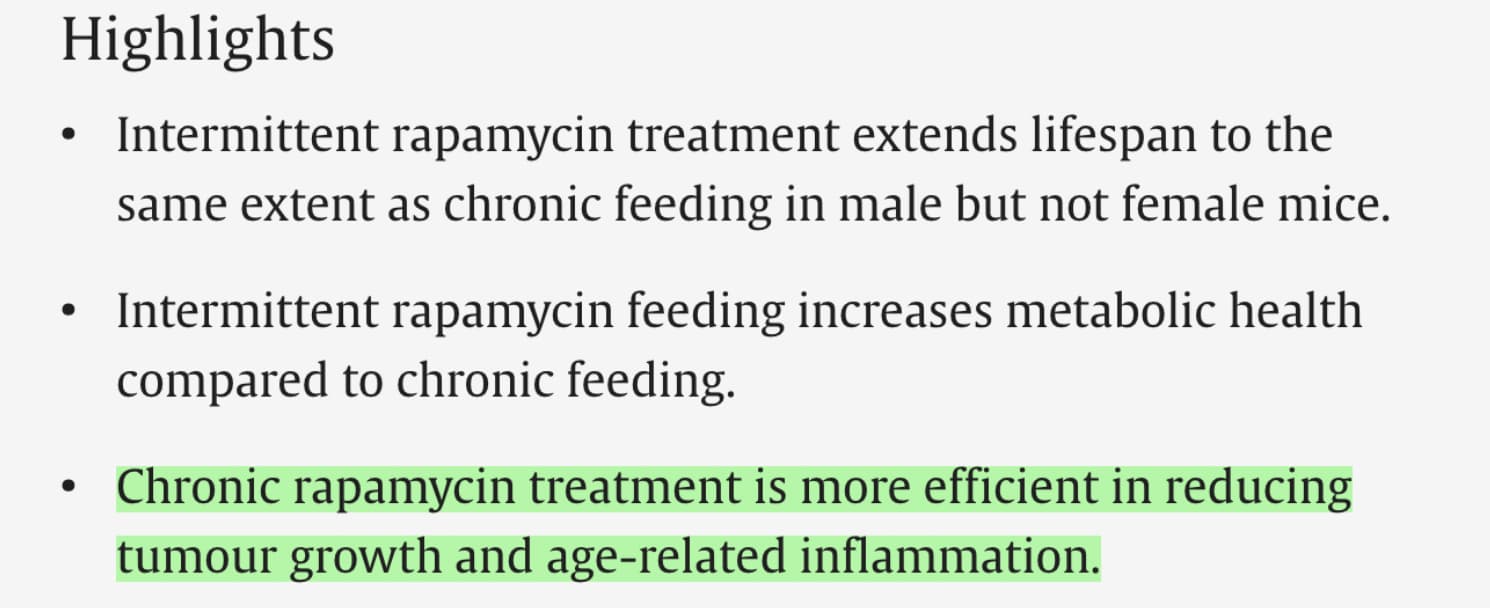Hi Paul, grateful for your considered and expert opinions. It’s a blessing to have you here.
Dr. Rivas,
The patient was initially bed-bounded and cachectic, somnolent, and barely able to sit, and bound for hospice
5 weeks after initiation of rapamycin low dose (0.5 mg 2x/ week):and now able to walk 7 steps; much more awake, a good appetite, but O2 saturation still dropped occasionally down to 80% or below on room air.
I took your advice: I felt that she was finally strong enough to withstand the difficult combination therapy against Mycobacterium Avium-Intracellulaire (MAI) and took a chance. Without MAI therapy, she will never get better; but MAI therapy is poorly tolerated. In order to improve the regimen’s tolerability, I adopted the intermittent dosing regimen (Azithromycin+ Ethambutol + Rifabutin 3x/ week.)
Thus: by turning the biological clock a little bit, low dose rapamycin may pull a hospice-bounded patient from the cliff and become candidate for treatment they would not have been able to tolerated.
PL
You’ve certainly done everything possible to resurrect this patient. Good for you and best of luck.
Thanks Paul for such an insightful response.
It’s interesting that you routinely use an ultrasound device instead of the antiquated stethoscope. With regards to carotid intimal thickness, here’s an interesting review of different treatment modalities . Some of this was surprising to me, though probably not to you.
- Intensive and prolonged statin therapy was necessary when lipid intervention was appropriate.
- Exercise is quite effective but resistance training in some studies actually resulted in a decrease in arterial elasticity.
- Mediterranean with high fiber diet seems best.
Are you familiar with the studies done on pine bark extract with Centella Asiatica on stabilizing atherosclerosis?
Interesting. I am curious to know if you had any success with rapamycin on resistant hypertension. Does it seem to reverse that somewhat and make medications more effective on lowering the bp?
Do you think that the pneumonia vaccines are effective and should rapamycin users consider getting it?
I have received two different vaccines because it prescribed for me as I am old, not because I take rapamycin.
An interesting review, by a cardiologist, on multiple human studies of the combination of pine bark with centella and its effects on atherosclerosis.
Calcification of Arteries: How to Reduce It? - Life Extension
Just a quick update. The severe hospice-bounded hypoxic cavitary Mycobacterium-avium patient is doing well 5 months after initiation of rapamycin, O2 sat better (room air O2 sat >90%).
I have used low dose weekly rapamycin this in three other very sick patients recently with different pathologies after failing conventional treatments. So far, I notice that rapamycin seems to make sick people more alert, but it is too early to tell whether rapamycin will help them also.
Ray has been doing this pill thing for decades. Perhaps he has accumulated some or even enough knowledge to be competent in this area.
His accomplishment history is pretty broad and give indication that he could have expertise in diverse areas.
That may be true, but without any data that he might share, its impossible to tell. If it was a strong positive, you’d think he’d share his results…
Full unpaywalled article (to the below write-up) here: https://archive.ph/CiwQW
Exactly.
PYC antagonizes the vasoconstriction caused by epinephrine and norepinephrine by increasing the activity of endothelial nitric oxide synthase
Hey guys… I can vouch that it is good for your "Johnson "
Read about Pine Bark on here around February 2023. Been on Pine Bark for a year now.
what is the low dose weekly that you are using? Have you considered chronic low doses? based on this study?
The study is published by Molecular Metabolism on Feb 13, 2024, hot off press.
https://www.sciencedirect.com/science/article/pii/S2212877824000334?via%3Dihub
It has some interesting highlights that are somewhat surprising:
The author (of the report) seems to think that a power of two can be divisible by 5.
I’ve taken Pycnogenol by life extension. Haven’t had any noticeable positive effects in terms of cognitive boost or otherwise. I stopped after several months because for me it seemed like a waste of money given the more effective stack I have.
I prefer my refined nootropics stack:
- Phenylpiracetam (Nanotropil) - 100mg
- Vinpocetine - 10mg
- Mexidol (Emoxypine) - 125mg
- Picamillon 20mg and/or Selank
- Ocassionally Semax - as anything that increases BDNF anectodally increases hair loss (although reversable when stopped). I noticed that so I don’t take it much.
Highly recommend Semax 0.1 % for those with a higher risk of stroke or age related cognitive decline. For example, in Eastern europe Semax is carried on every ambulence and is admistered in the ER immediately to Stroke patients. - Several eggs a day (must be pasture raised and corn and soy free) or Ocassional Alpha GPC - 300mg
- L-theanine - 200mg if I ever drink caffeine. I don’t tend to drink much coffee.
- Lithium Orotate - 1mg
- Have tried Zyn’s but stopped after a week. Nicotine decreases thiamine (B1) big time hence why the energy drain after it. Only way I would take Zyn’s is with large doses of thiamine.

